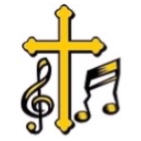Applied Gospel Chords
Musical chords can be categorized according to their uses when playing Traditional Gospel Music. Some chords may be listed in more than one category because of their multiple uses. There are at least five uses of chords. These uses are identified by category names:
Melody chords are chords built around the melody notes of a song. Melody notes are the tune of the song. They are the root notes of melody chords. Melody notes are the pitches a soloist would sing. They are the foundation upon which the song is built. Melody chords support the melody and are the foundation upon which the musical piece is built.
Melody chords allow the musician to successfully play the song. Other chords are required to add color, depth, spice and flavor to the musical piece. The proper combination of melody chords and other chords is what gives Traditional Gospel Music itís unique down home sound.
When playing in the key of C Major, melody chords can usually be found by choosing from the following list: C major triad, F major triad, G major triad and G dominant seventh. These chords are played using the root position as well as the first and second inversions.
Alternate chords are chords played in lieu of melody chords. The melody note is played as the highest pitch in the chord. However, the other tones of alternate chords are different from the non-melody tones of melody chords. Alternate chords are used instead of melody chords to give a musical piece color.
|
Alternate Chords used when playing in C major
|
|
Fm6/R
|
Played without the fifth degree in lieu of G/2 or G7/4.
|
|
G6/R
|
Played with optional fifth degree in liew of C/3.
|
|
E/2
|
Played in liew of C/3.
|
|
A6/4
|
Played in liew of C/3.
|
|
Am/3
|
Played in liew of C/2.
|
|
Am6/4
|
Played in liew of C/3.
|
|
Dm/2
|
Played in liew of G7/4.
|
Change chords reflect a change in the harmonic tones of a melody chord while the melody note remains the same. Change chords are a type of melody chord because they are built around the melody note. However, they differ from melody chords in that the melody note of a change is chord is held instead of being repeated or changed. A change chord reflects the change in inflection of the voice of the person singing the melody note of a song. Change chords add depth to a musical piece.
Change chords can be subcategorized into first, second and third change chords. These subcategories are based on the inversion of the chord from which the change was made. Chords changed from the first inversion of a triad are called first change chords. Chords changed from the second inversion of a triad are called second change chords. Chords changed from the root position of a triad are called third change chords.
|
First Change Chords changed from C/2
|
|
Cdim7/2
|
F/R
|
F6/4
|
F7/4
|
Fm/R
|
Fm6/4
|
Fm7/4
|
|
Second Change Chords changed from C/3
|
|
G6/4 w/o the 5th degree
|
E/2
|
A/R
|
A7/4
|
Am/R
|
Am6/4
|
|
Third Change Chords changed from C/R
|
Fill-in chords are chords played in transition when changing from one melody chord to another. They do not contain melody notes. Therefore, they are not melody chords. Fill-in chords add spice to the musical piece.
Fill-in chords are played solely at the discretion of the musician. They reflect the musician's creativity and artistry. A musician's feelings and emotions are expressed through the use of fill-in chords. Using these chords, the musician performs a unique arrangement of the musical piece.
|
Fill-in Chords used when playing in C major
|
|
C7/4
|
Cdim7/R
|
G7 w/o R
|
E7 w/optional R
|
D7 w/optional R
|
Dm/2
|
Lead-in chords are similar to fill-in chords. Both are played in transition from one melody chord to another. However, lead-in chords are melody chords. They are optional chords that help the song along (as by the singing of "Oh"). A lead-in chord is usually the same as the last melody chord played. Lead-in chords add flavor to a musical piece.
|
Lead-in Chords used when playing in C major
|
|

